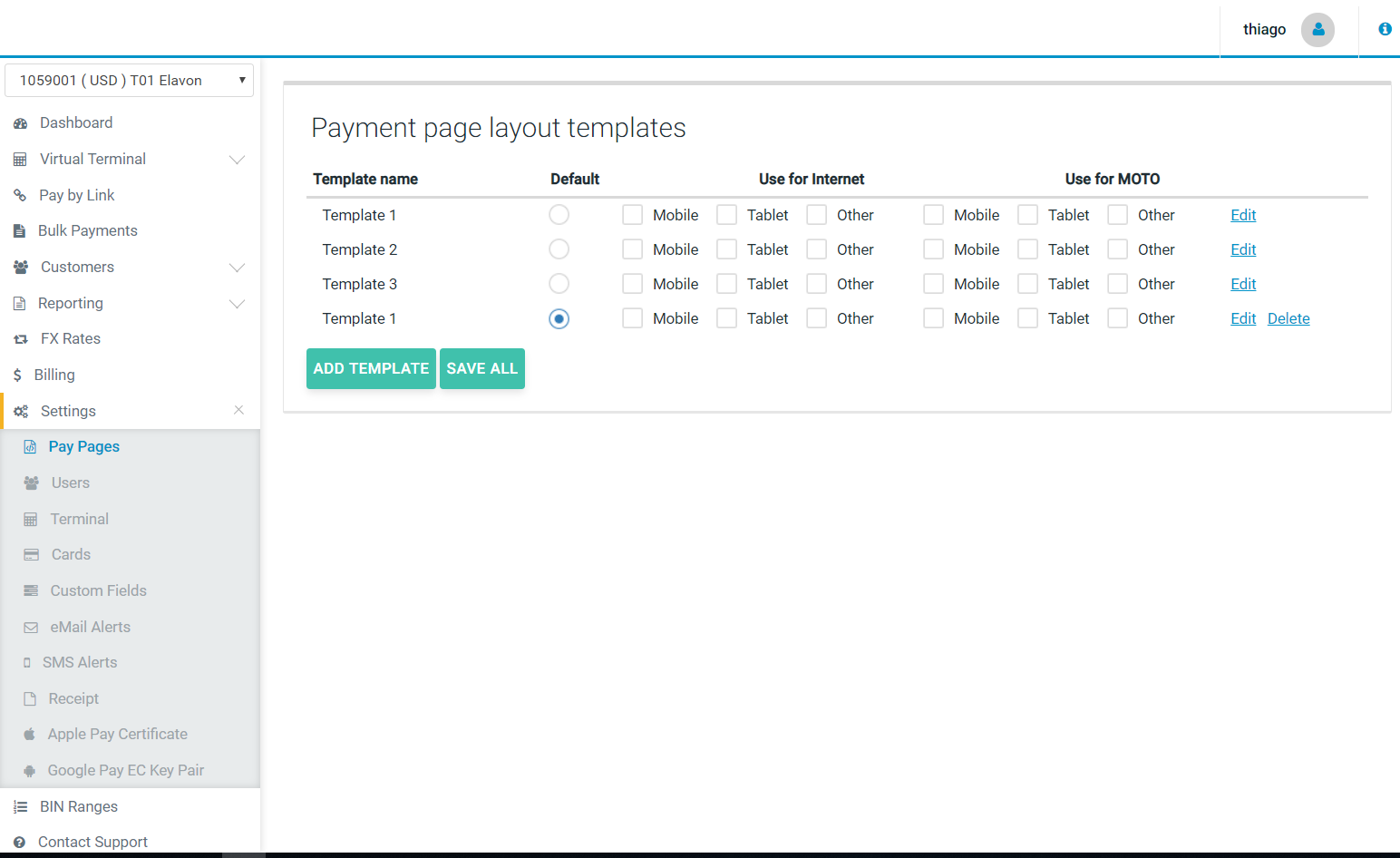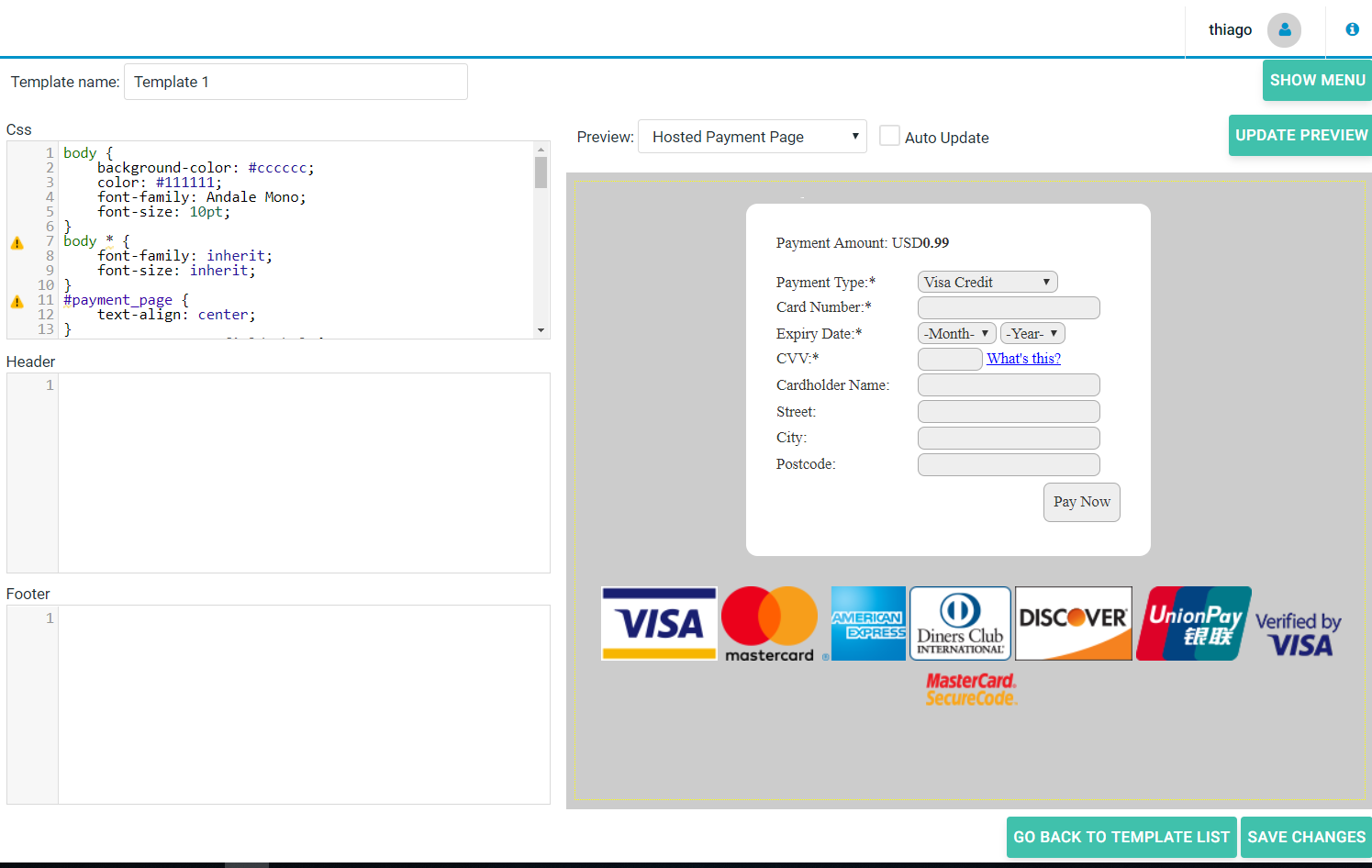Pay Pages
The styling of Hosted Payment Pages is performed by the merchant and can be done in two ways: basic styling with a simple template editor or completely customized using CSS/HTML. The Hosted Payment Pages are device aware, responsive and reactive. You can locate the Pay Pages styling functionality in the Settings tab in the SelfCare System (Merchant Portal).
Select Pay Pages from the drop down box to view the hosted payment page layout template options. The payment page template can also be designed to accept MOTO (Mail Order/Telephone Order) transactions from mobile devices by checking the Mobile or Tablet boxes under “Use for MOTO”.

As you can see from the image above, it is simple to configure separate templates to be used for various devices. This is intended as a shortcut; a simple alternative to creating a fully responsive page. Note that a single template can be made totally responsive if desired.
Also, different templates can also be used for Mail Order (MOTO) and eCommerce transactions (WEB).
There are three permanent templates and they default to some sample styles. They do not all have to be used.
The Hosted Pages can have images included on them, but these image files must be hosted on the merchants website. This way, the URL image can be used in the Payment Page styling.
In the screen above, if you click on Add Template or select Edit for one of the templates listed, you will arrive at the template real-time editor. Note that the Style Editor provides the ability to scroll through many different parameter settings for your payment page. On the right side of your screen is a real time preview of the payment page as it would appear with the current parameter selections if the auto update box is checked. The payment page parameters may be individually selected for a Hosted Payment Page, Secure Card (tokens) and Subscription screens.
Only users who have “Pay Pages” permissions will have access to this interface. It can be found once logged in by clicking “Settings” and then “Pay Pages” in the menu.

Basic template styling requires no knowledge of HTML or CSS. It can allow a merchant to style the page on their own. Previews of all hosted pages can be viewed on the right hand side.
All new templates created are basic. It's best to style as close as possible to what you are looking for in this mode before clicking “Advanced Mode” for more options.
Also, notice that switching from the Basic Editor to Advanced Mode is a one-way only change. After switching to Advanced Mode, you will not be able to switch back to the basic editor to edit this template. A warning box will appear if this option is chosen which will ask if you want to continue or cancel. If you choose this option in error, select Cancel to go back to the Basic Editor.

Advanced mode allows you to directly edit the CSS of the page and also the HTML of the Header and Footer. It is recommended not to use Auto Update in this mode. The @import CSS tag is blocked for HPP customization.
Because of the custom CSS that cannot be reverted to the same constraints as the Basic Mode, once you have entered Advanced mode you cannot go back to Basic Mode styling.
Scroll down to see all the options offered by the Style Editor and to review each change as it appears on the Preview screen.
When finished with your parameter selections, select Save Changes or Return to Template List.
Using Level 3 Enhanced Data
If you are using enhanced data, more specificaly, Level 3 enhanced data, your transactions might have items. If you want them to be visible for your customer, you should mark Display Enhanced Data or manually add the following piece of style to your template.
a#enhancedDataLink { color: #0000ff; text-decoration: none; } #enhancedData { display: none; } #enhancedData h4 { font-size: 1.2em; border-bottom: 1px solid #eeeeee; padding-bottom: 0.6em; margin-bottom: 0.6em; } #enhancedData ul { padding: 0; list-style: none; border-bottom: 1px solid #eee; padding: 0 0.6em 0.6em; margin-bottom: 0.6em; } #enhancedData .total, #enhancedData .summary { border: 1px solid #ccc; background: none; border-radius: 5px; padding: 0.6em; } #enhancedData li { display: table; width: 100%; padding: 0.2em 0 0.4em; } #enhancedData li span { display: table-cell; } #enhancedData .label { padding-right: 1em; min-width: 100px; } #enhancedData .info { text-align: right; } .bold { font-weight: bold; }